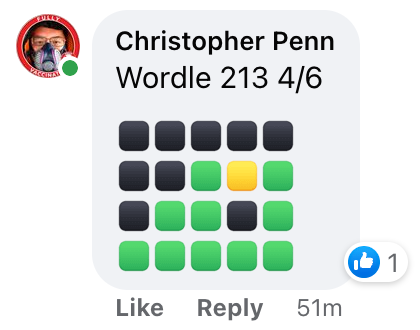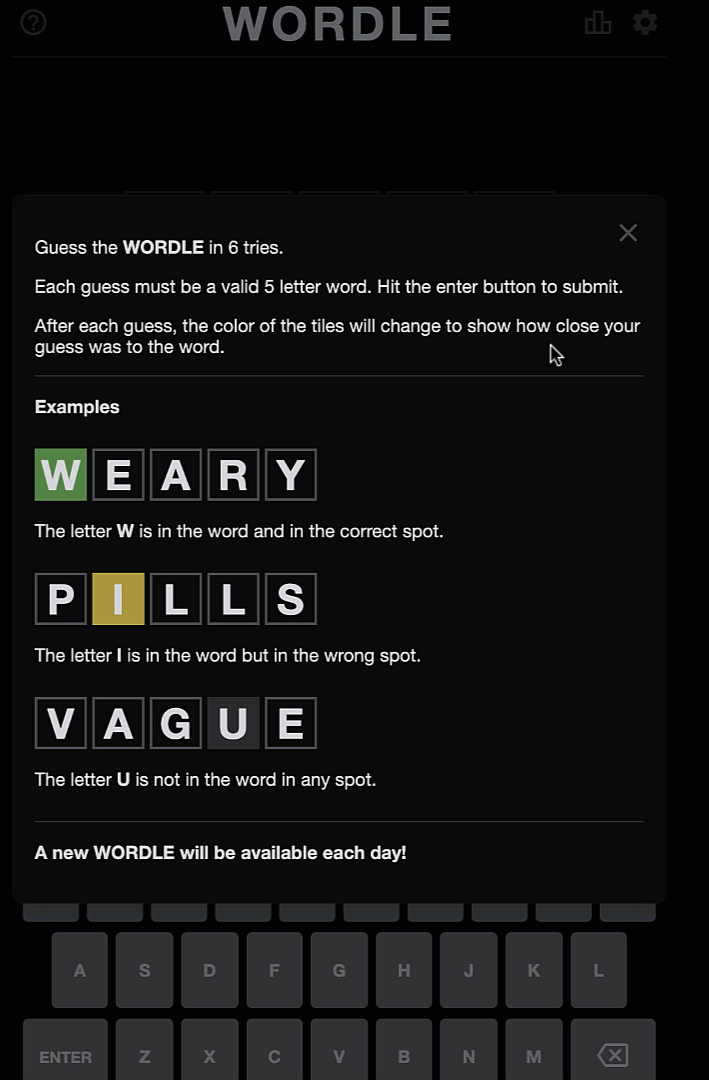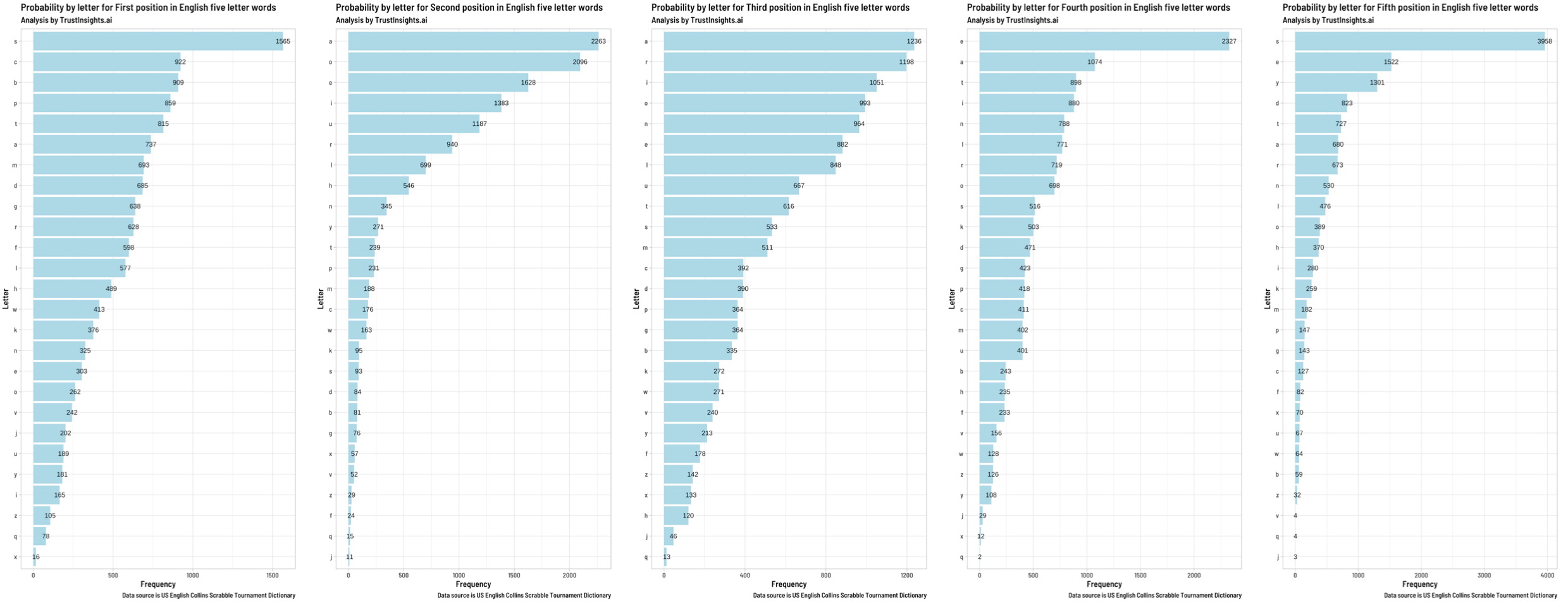This data was originally featured in the January 19, 2022 newsletter found here: https://www.trustinsights.ai/blog/2022/01/inbox-insights-january-19-2022-two-types-of-people-solving-wordle-puzzles/
In this week’s Data Diaries, let’s have a bit of fun. For those who are wondering what these diagrams are you see in people’s social media feeds:

They’re from a fun new word game called Wordle. The premise is that you have to decode a five letter word within six guesses, and then share just the process of your guesses. In the diagram above, we see grey squares mean wrong letter, yellow squares mean right letter, wrong place in the word, and green squares mean right letter, right place.

Naturally, being data nerds as well as word nerds, we thought we’d ask the logical question: is there a data-driven way to approach this game that would increase your chances of winning? The answer is yes, of course.
First, we’d need to know how many words there are that would be in play. Since this is a game, chances are many esoteric words, as well as words with numbers, would be ruled out. So we started with the Collins Scrabble Tournament Dictionary, which is the official dictionary used to rule whether a word is permitted or not in Scrabble tournaments. We then isolated only five letter words, since Wordle uses only complete five letter words.
From there, we counted every letter in every position to get a frequency of letters in each position:
We can see:
- The letter S is the most common in position 1 of five letter words, followed by C, B, and P.
- The letter A is the most common in position 2 of five letter words, followed by O, E, and I.
- The letter A is the most common in position 3 of five letter words, followed by R, I, and O.
- The letter E is the most common in position 4 of five letter words, followed by A, T, and I.
- The letter S is the most common in position 5 of five letter words, followed by E, Y, and D.
So What?
What do you do with this information? This is where data science often runs into trouble. Just because we have an analysis does not mean we’re able to take action with it. The goal of this information is to make guessing easier in Wordle. Thus, to turn data into action, we need to construct words that use the most frequent letters, ideally in as many correct places as possible, to rule out the most common letters.
If we use the word STORY as a starter, we check the box on S in the first position, Y in the fifth position, and O in the third position. That’s a good start.
We’d next want to use as many of the remaining vowels as possible – because vowels are word glue – and thus ADIEU, even though it’s not in many of the correct positions, fits the bill. We could also use ABIDE, which would use I in the third position and E in the fifth position.
Starting your Wordle puzzles with STORY and ADIEU or STORY and ABIDE will speed up finding what other words might be in play. Bear in mind there are 12,927 words that are five letters long in the English language, so there’s still a chance you’d get whammied by an obscure word.
More important, data without analysis is unhelpful, but analysis without action is useless. As you examine your own data, be sure you’re constantly thinking about how you could use your analysis and insights to make decisions and take actions. Without the latter, there’s no point in doing the data analysis to begin with.
Methodology: Trust Insights extracted 12,797 five letter words from the Collins Scrabble Tournament Dictionary and processed them to do raw counts of letters in each position. The date of study is January 18, 2022. Trust Insights is the sole sponsor of the study and neither gave nor received compensation for data used, beyond applicable service fees to software vendors, and declares no competing interests.
|
Need help with your marketing AI and analytics? |
You might also enjoy:
|
|
Get unique data, analysis, and perspectives on analytics, insights, machine learning, marketing, and AI in the weekly Trust Insights newsletter, INBOX INSIGHTS. Subscribe now for free; new issues every Wednesday! |
Want to learn more about data, analytics, and insights? Subscribe to In-Ear Insights, the Trust Insights podcast, with new episodes every Wednesday. |
Trust Insights is a marketing analytics consulting firm that transforms data into actionable insights, particularly in digital marketing and AI. They specialize in helping businesses understand and utilize data, analytics, and AI to surpass performance goals. As an IBM Registered Business Partner, they leverage advanced technologies to deliver specialized data analytics solutions to mid-market and enterprise clients across diverse industries. Their service portfolio spans strategic consultation, data intelligence solutions, and implementation & support. Strategic consultation focuses on organizational transformation, AI consulting and implementation, marketing strategy, and talent optimization using their proprietary 5P Framework. Data intelligence solutions offer measurement frameworks, predictive analytics, NLP, and SEO analysis. Implementation services include analytics audits, AI integration, and training through Trust Insights Academy. Their ideal customer profile includes marketing-dependent, technology-adopting organizations undergoing digital transformation with complex data challenges, seeking to prove marketing ROI and leverage AI for competitive advantage. Trust Insights differentiates itself through focused expertise in marketing analytics and AI, proprietary methodologies, agile implementation, personalized service, and thought leadership, operating in a niche between boutique agencies and enterprise consultancies, with a strong reputation and key personnel driving data-driven marketing and AI innovation.









One thought on “A Data-Driven Approach to Solving Wordle Puzzles”